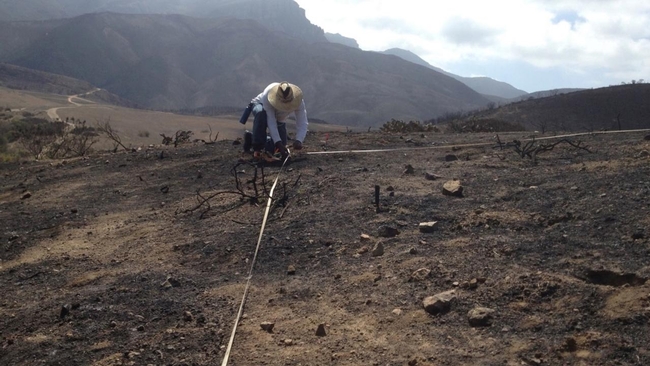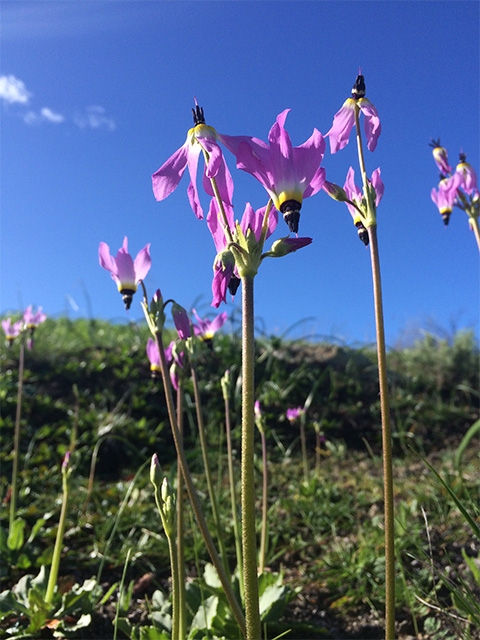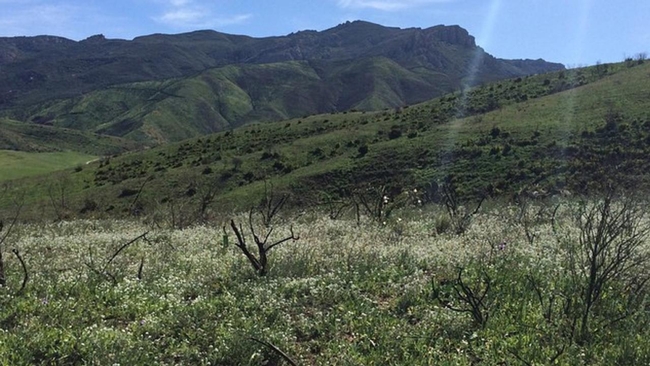Posts Tagged: Native Plants
Using Native Plants for Weed Control
One of the first steps in ecological restoration is often controlling invasive weeds, which can be a major barrier to native plant establishment. But what happens after restoration is complete? At most sites, weed pressure is an ongoing challenge that...
Lawn-pocalypse! Surviving Drought
Ah, summer! The season of sunburns, pool parties, and… lawn droughts. If your once lush, green carpet now looks like a crunchy brown doormat, you're not alone. Let's dive into why your yard is staging a dramatic death scene and what you can do to...

Bermuda grass and weeds overtaking drought stressed turf grass.
Car fumes, weeds pose double-whammy for fire-loving native plants
Wildflower displays threatened
Northwest of Los Angeles, springtime brings native wildflowers to bloom in the Santa Monica Mountains. These beauties provide food for insects, maintain healthy soil and filter water seeping into the ground – in addition to offering breathtaking displays of color.
They're also good at surviving after wildfire, having adapted to it through millennia. But new research shows wildflowers that usually would burst back after a blaze and a good rain are losing out to the long-standing, double threat of city smog and nonnative weeds.
A recent study led by Justin Valliere, assistant professor in the UC Davis Department of Plant Sciences, found that native wildflowers and other plants that typically flourish following a fire were, instead, replaced by invasive plants on land that received the kind of nitrogen contained in vehicle emissions.
“Many native plants in fire-prone areas rely on fire, and some are entirely dependent on it. Some are even most abundant after a fire,” said Valliere, a UC Cooperative Extension specialist in invasive weed and restoration ecology. “But we found that these fire-following species may be especially vulnerable to the combination of nitrogen pollution and invasive plants.”
That's part of the reason why native plants in these mountains have been declining.
Seeds – banked in the soil and waiting to sprout
The problem faced by native plants can be compared to a drawn-down bank account: Funds withdrawn are not being replaced.
It starts with fire, an important ecological process, Valliere said. Flames burn through plants on the surface and return their nutrients to the soil. Seeds sleeping in the ground wait for the next rain to sprout, then use those nutrients to grow.
“Plant diversity is often highest in growing seasons immediately after a site burns,” he said.
But invading plants have many advantages over native ones. They often sprout earlier, grow faster and create more seeds, all while tolerating drought.
“They're like cheaters,” Valliere said. “They don't follow the same rules.”
Nitrogen, too, is an important piece of every plant's nutrition. They all get a fertilizing boost from nitrogen that floats up in vehicle emissions and falls to the ground. But the invaders use nitrogen and other nutrients to grow faster, winning the race for water and sunlight. As a result, fewer native plants reach maturity, producing fewer seeds that keep their populations thriving.
When the bank balance reaches zero
The 2013 Springs Fire gave Valliere a unique opportunity to study the combined impacts of wildfire and extra nitrogen. He and colleagues from UC Riverside and the National Park Service created test plots in the Santa Monica Mountains where the fire had burned. Then, they added nitrogen to the soil to mimic the amount and type that LA's smog would deposit. Over the study's three years, native plants that typically would have flourished after wildfire instead declined even faster in the plots with added nitrogen.
Native seeds sprouted, but didn't flower. Over time, the soil's bank of seeds drew down.
“Each seed has one chance to flower and reproduce,” Valliere said. “If a seed grows and gets outcompeted, that seed has lost its chance to replenish the seed bank.”
Without the chance to replenish their bank account, native plants will die out, and the whole ecosystem will be thrown out of balance.
“There is inherent value in biodiversity,” Valliere said. “These invasive weeds could prevent the re-establishment of native shrubs after fire, sometimes forever altering the plant community.”
The loss of native plants can have cascading effects on the larger environment, he added. Problems can include the loss of native bees that feed on the flowers, and mudslides when rain makes hillsides unstable.
This problem is likely to repeat in similar areas where biodiversity is highest after wildfires – including parts of the Mediterranean basin, southern Africa and Australia. The addition of city smog “could have serious consequences for the biodiversity of fire-prone ecosystems worldwide,” Valliere warned.
Read the paper, “Nitrogen deposition suppresses ephemeral post-fire plant diversity,” by Justin Valliere, Irina Irvine and Edith Allen.
This article was first published on the UC Davis Department of Plant Sciences website.
High Summer in the Native Plant Garden
We Californians understand the concept of summer dormancy: “Those hills aren't brown, they're beautifully golden!” We know that the cycle of seasons plays out a bit more dramatically across our hot, dry countryside than in locales where the...
Climate-Change Resources
University of California UC ANR Green Blog (Climate Change and Other Topics) https://ucanr.edu/blogs/Green/index.cfm?tagname=climate%20change (full index)
Examples:
- Save Trees First: Tips to Keep Them Alive Under Drought https://ucanr.edu/b/~CdD
- Landscaping with Fire Exposure in Mind: https://ucanr.edu/b/~G4D
- Cities in California Inland Areas Must Make Street Tree Changes to adapt to Future Climate https://ucanr.edu/b/~oF7
Drought, Climate Change and California Water Management Ted Grantham, UC Cooperative Extension specialist (23 minutes) https://youtu.be/dlimj75Wn9Q
Climate Variability and Change: Trends and Impacts on CA Agriculture Tapan Pathak, UC Cooperative Extension specialist (24 minutes) https://youtu.be/bIHI0yqqQJc
California Institute for Water Resources (links to blogs, talks, podcasts, water experts, etc.) https://ciwr.ucanr.edu/California_Drought_Expertise/
UC ANR Wildfire Resources (publications, videos, etc.) https://ucanr.edu/News/For_the_media/Press_kits/Wildfire/ (main website)
-UC ANR Fire Resources and Information https://ucanr.edu/sites/fire/ (main website)
-Preparing Home Landscaping https://ucanr.edu/sites/fire/Prepare/Landscaping/
UC ANR Free Publications https://anrcatalog.ucanr.edu/ (main website)
- Benefits of Plants to Humans and Urban Ecosystems: https://anrcatalog.ucanr.edu/pdf/8726.pdf
-Keeping Plants Alive Under Drought and Water Restrictions (English version) https://anrcatalog.ucanr.edu/pdf/8553.pdf
(Spanish version) https://anrcatalog.ucanr.edu/pdf/8628.pdf
- Use of Graywater in Urban Landscapes https://anrcatalog.ucanr.edu/pdf/8536.pdf
- Sustainable Landscaping in California https://anrcatalog.ucanr.edu/pdf/8504.pdf
Other (Non-UC) Climate Change Resources
Urban Forests and Climate Change. Urban forests play an important role in climate change mitigation and adaptation. Active stewardship of a community's forestry assets can strengthen local resilience to climate change while creating more sustainable and desirable places to live. https://www.fs.usda.gov/ccrc/topics/urban-forests
Examining the Viability of Planting Trees to Mitigate Climate Change (plausible at the forest level) https://climate.nasa.gov/news/2927/examining-the-viability-of-planting-trees-to-help-mitigate-climate-change/
Reports and other information resources coordinated under the auspices of the United Nations and produced through the collaboration of thousands of international scientists to provide a clear and up to date view of the current state of scientific knowledge relevant to climate change. United Nations Climate Action
Scientific reports, programs, action movements and events related to climate change. National Center for Atmospheric Research (National Science Foundation)
Find useful reports, program information and other documents resulting from federally funded research and development into the behavior of the atmosphere and related physical, biological and social systems. Search and find climate data from prehistory through to an hour ago in the world's largest climate data archive. (Formerly the "Climatic Data Center") National Centers for Environmental Information (NOAA)
Think tank providing information, analysis, policy and solution development for addressing climate change and energy issues (formerly known as the: "Pew Center on Global Climate Change"). Center for Climate & Energy Solutions (C2ES)
Mapping Resilience: A Blueprint for Thriving in the Face of Climate Disaster. The Climate Adaptation Knowledge Exchange (CAKE) was launched in July 2010 and is managed by EcoAdapt, a non-profit with a singular mission: to create a robust future in the face of climate change by bringing together diverse players to reshape planning and management in response to rapid climate change. https://www.cakex.org/documents/mapping-resilience-blueprint-thriving-face-climate-disaster
Cal-Adapt provides a way to explore peer-reviewed data that portrays how climate change might affect California at the state and local level. We make this data available through downloads, visualizations, and the Cal-Adapt API for your research, outreach, and adaptation planning needs. Cal-Adapt is a collaboration between state agency funding programs, university and private sector researchers https://cal-adapt.org/
Find reports, maps, data and other resources produced through a confederation of the research arms of 13 Federal departments and agencies that carry out research and develop and maintain capabilities that support the Nation's response to global change. Global Change (U.S. Global Change Research Program)
The Pacific Institute is a global water think tank that combines science-based thought leadership with active outreach to influence local, national, and international efforts to develop sustainable water policies. https://pacinst.org/our-approach/
Making equity real in climate adaptation and community resilience policies and programs: a guidebook. https://greenlining.org/publications/2019/making-equity-real-in-climate-adaption-and-community-resilience-policies-and-programs-a-guidebook/
Quarterly CA Climate Updates and CA Drought Monitor Maps (updated each Thursday) https://www.drought.gov/documents/quarterly-climate-impacts-and-outlook-western-region-june-2022




